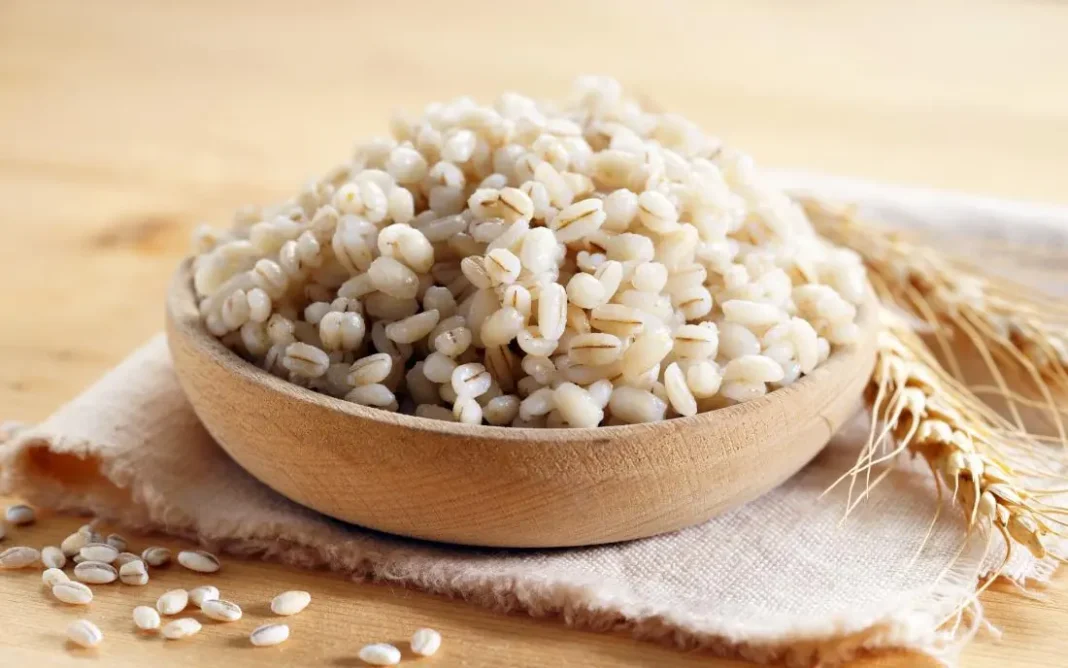Barley is a cereal grain that people can use in bread, beverages, stews, and other dishes. As a whole grain, barley provides fiber, vitamins, and minerals. These offer various health benefits.
Consuming a diet rich in whole grains may help reduceTrusted Source the risk of obesity, diabetes, heart disease, certain types of cancer, and other chronic health concerns.
This article looks at barley’s nutritional content and benefits, and it lists some reasons that some people may need to avoid consuming it. It also provides some tips on using and preparing it, as well as some recipes.
Nutrition
Stores usually sell barley in two forms: hulled and pearled.
Hulled barley undergoes minimal processing to remove only the inedible outer shell, leaving the bran and germ intact.
Pearled barley has neither the hull nor the bran.
The table below shows the nutrients per 100 grams (g) of uncooked hulled and pearl barley.
It is important to note that barley will usually expand to three and a half times its volume when cooked. Typically, a person will eat half a cup of cooked barley weighing around 78.5 g.
The table also shows the daily recommended intake of nutrients for adults aged 19 years and above, according to the 2015–2020 Dietary Guidelines for Americans. Individual recommendations will vary according to age, sex, activity levels, overall health status, and other factors.
| Nutrient | Hulled barley | Pearl barley | Recommended adult intake |
| Energy (calories) | 354 | 352 | 1,600–3,000 |
| Protein (g) | 12.5 | 9.9 | 46–56 |
| Fat (g) | 2.3 | 1.2 | 20–35 |
| Carbohydrate (g) | 73.5 | 77.7 | 45–65 |
| Fiber (g) | 17.3 | 15.6 | 22.4–33.6 |
| Calcium (milligrams [mg]) | 33 | 29 | 1,000–1,200 |
| Iron (mg) | 3.6 | 2.5 | 8–18 |
| Magnesium (mg) | 133 | 79 | 320–420 |
| Phosphorus (mg) | 264 | 221 | 700 |
| Potassium (mg) | 452 | 280 | 4,700 |
| Sodium (mg) | 12 | 9 | 2,300 |
| Manganese (mg) | 1.9 | 1.32 | 1.8–2.3 |
| Selenium (micrograms [mcg]) | 37.7 | 37.7 | 55 |
| Folate (mcg) | 19 | 23 | 400 |
Barley is also a rich source of B vitamins, including niacin, thiamin, and pyridoxine (vitamin B-6). It also contains beta-glucans, a type of fiber that scientists have linkedTrusted Source to various health benefits.
Why do dietitians recommend eating more whole grains? Find out here.
The sections below discuss the various health benefits of barley in more detail.
Heart health and blood pressure
Various nutrients in barley support the cardiovascular system. These include:
Vitamins and minerals
Barley’s potassium, folate, iron, and vitamin B-6 content, together with its lack of cholesterol, all support cardiovascular functions.
For example, researchTrusted Source has suggested that consuming a diet rich in vitamin B-6 and folate may help reduce levels of a compound called homocysteine. Having high levels of homocysteine may increase the risk of heart disease.
Other studiesTrusted Source have indicated that eating a diet rich in these nutrients may help reduce heart disease risk factors such as high blood pressure.
Folate and iron are particularly important for forming red blood cells and oxygenating the blood, which is important for overall heart health.
Niacin, riboflavin, thiamin, folate, iron, magnesium, and selenium all enhance the processes of cell formation, such as carrying oxygen through the blood, and the functioning of the immune system. Barley is a good source of all these nutrients.
Sodium and potassium
The American Heart AssociationTrusted Source (AHA) recommend avoiding foods that are very high in sodium, such as fast foods. Instead, consuming vegetables, fruits, grains, and other potassium-rich foods may help maintain healthy blood pressure.
Fiber
Fiber appears to boost heart healthTrusted Source by helping manage blood pressure and controlling cholesterol levels.
More specifically, the beta-glucan fiber present in barley reduces low density lipoprotein, or “bad,” cholesterol by binding to bile acids and removing them from the body via excretion. In fact, according to one 2008 studyTrusted Source, consuming 3 g of beta-glucans per day from certain barley products can reduce total cholesterol by 5–8%.
In 2008, researchers found that eating a lot of high beta-glucan pearled barley significantly reduced high serum cholesterol levels and lowered visceral fat in Japanese men. These are both risk factors for cardiovascular disease.
Bone health
The phosphorus, calcium, copper, magnesium, and zinc in barley all contribute to improved bone structure and strength.
For example, zinc plays a roleTrusted Source in bone mineralization and development. Calcium, copper, magnesium, and phosphorus, meanwhile, contribute to bone health and are essential for maintaining a strong skeletal system.
Cancer
Barley contains selenium. Getting selenium from the diet can help prevent inflammation, according to a studyTrusted Source from 2012.
According to the National Cancer InstituteTrusted Source, people with some types of chronic inflammation — such as Crohn’s disease — have a higher risk of cancer. This is because persistent inflammation can sometimes trigger the DNA changes that cause cells to divide uncontrollably.
Selenium also acts as an antioxidant, protecting cells against damage caused by molecules called free radicals. This type of damage may increase the risk of cancer.
A high intakeTrusted Source of fiber from plant based foods such as barley may also help lower the risk of colorectal cancer, specifically.
Also, some evidenceTrusted Source suggests that beta-glucan fiber may benefit the immune system and have anticancer effects. Some people take it as a supplement, but researchers are examining ways of incorporating it into immunotherapy treatment for cancer.
For this reason, some people believe that consuming foods that contain beta-glucans may help prevent cancer. However, more research is needed to confirm this potential health benefit.
How can diet affect cancer? Find out here.
Inflammation
Choline is another nutrient that may help reduceTrusted Source inflammation. Barley containsTrusted Source betaine, which the body can convert to choline.
Choline helps with sleep, muscle movement, learning, and memory. It also helps maintain the structure of cellular membranes, aids the transmission of nerve impulses, and assists in the absorption of fat.
What is an anti-inflammatory diet, and how can it help? Learn more here.
Digestion, weight management, and satiety
Barley’s fiber content helps prevent constipation and promote regularity for a healthy digestive tract.
Eating fiber-rich foods such as barley may also contributeTrusted Source to weight loss. This is because it functions as a “bulking agent” in the digestive system, making a person feel fuller for longer. This may reduce calorie consumption and promote weight loss.
Effective weight management can also helpTrusted Source reduce obesity and related complications, such as type 2 diabetes, cardiovascular disease, and other health issues.
Dietary tips
Barley is a versatile grain with a nutty flavor and a chewy, pasta-like texture. People can prepare it in various ways.
In the sections below, we list some preparation methods for different types of barley.
Hulled barley
Hulled barley has a chewier consistency than pearled barley. It needs longer soaking and cooking times due to its outer bran layer.
Soaking will reduce the cooking time and achieve optimal flavor and texture.
To prepare hulled barley:
- Put the barley in a pan with twice its volume of water.
- Leave it to soak for several hours.
- Drain and rinse before cooking.
- Add 1 cup of grain to 3 cups of water or broth.
- Bring it to a boil.
- Reduce the heat and let it simmer for around 45 minutes.
Pearled barley
To prepare pearled barley, follow the same process as for hulled barley but without soaking it. Cooked from dry, a cup of barley will need 3 cups of liquid.
Quick tips
Here are some tips for using barley:
- After cooking, add it to any pot of soup or stew to give it body and flavor.
- Cook it in broth and add vegetables to make a tasty pilaf or risotto.
- Toss chilled, cooked barley with diced vegetables and homemade dressing for a quick cold salad.
- Combine barley with onion, celery, mushrooms, carrots, and green pepper. Add broth to the mixture, bring it to a boil, and then bake for approximately 45 minutes for an easy and healthful barley casserole.
Does barley water have any benefits? Find out here.
Recipes
Try these healthful barley recipes:
- Barley stew with leeks, mushrooms, and garlic
- Barley salad with feta and pine nuts
- Barley porridge with blueberries
Risks
Barley contains gluten, so it is not suitable for people with celiac disease, a wheat allergy, or a nonceliac gluten sensitivity. Malt, malted beverages such as beer, and several flavorings use barley as a base. As a result, they too contain gluten.
It is also important that people who want to increase their fiber intakeTrusted Source do so gradually. This is because suddenly adding lots of fiber to the diet may lead to temporary digestive problems, such as bloating, as the body adjusts to the change.
Drinking plenty of liquids while increasing fiber intake can help prevent constipation.



